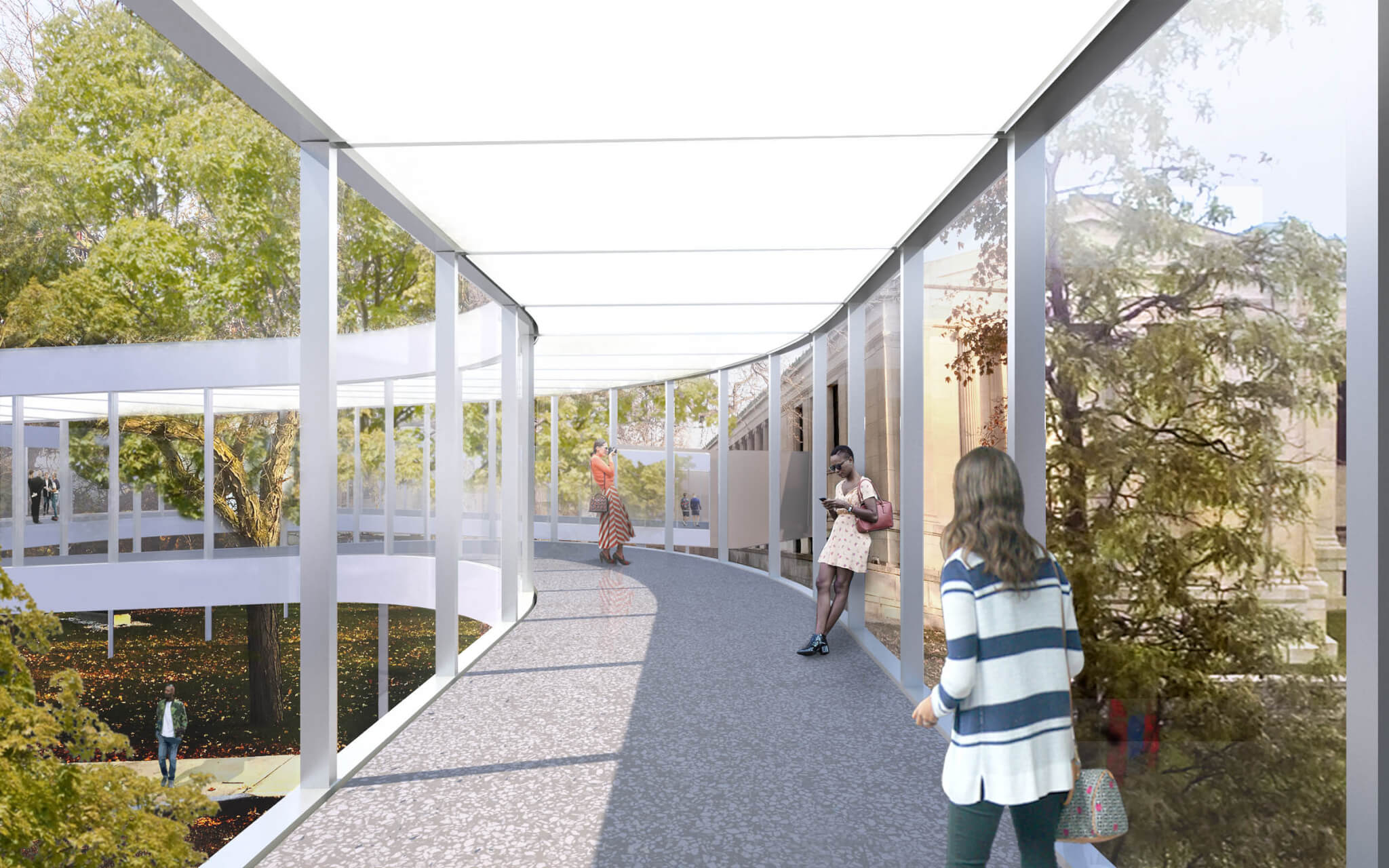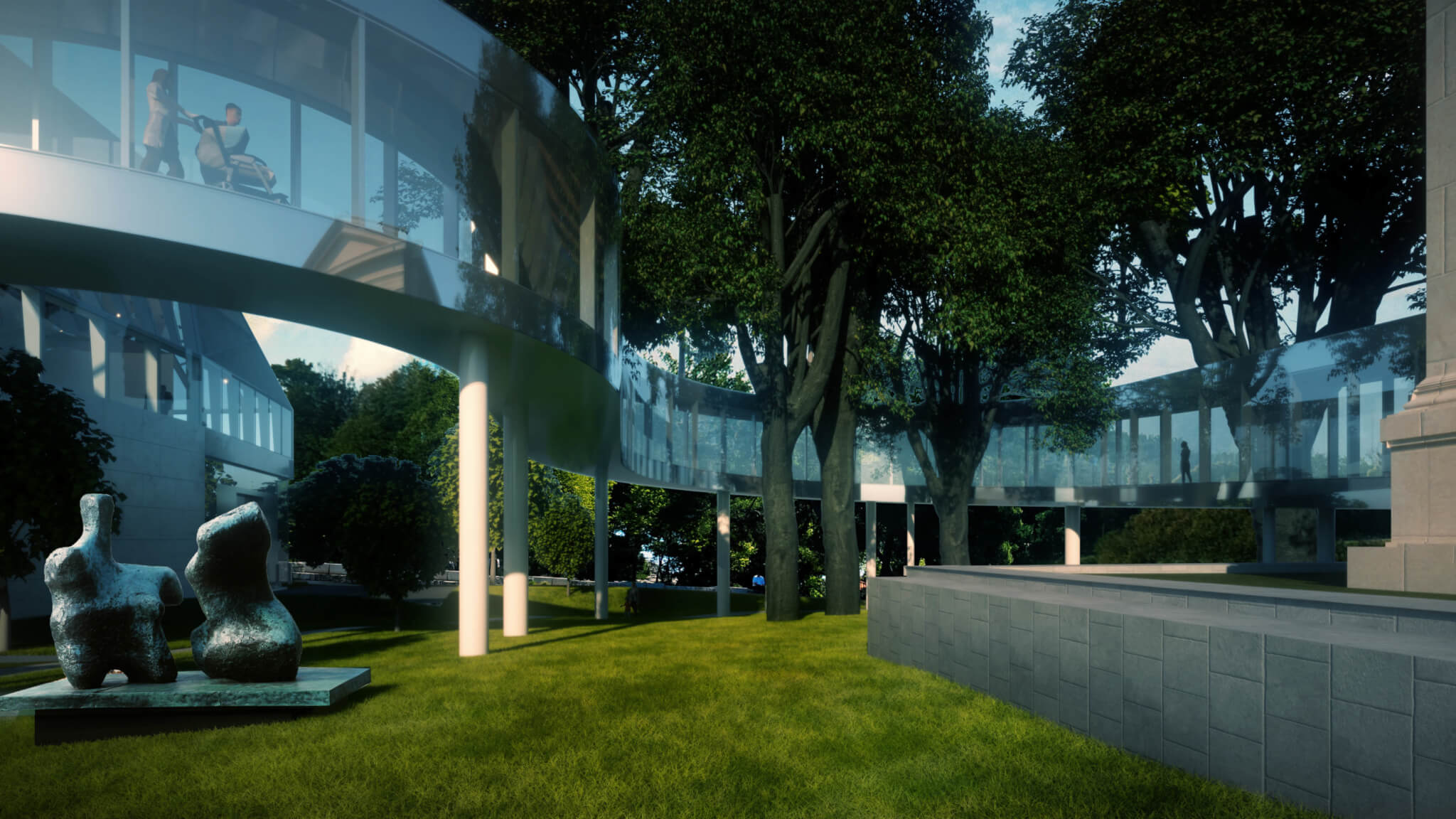The long-awaited, OMA-led expansion of the Buffalo AKG Art Museum in Buffalo, New York, now has an opening date. On May 25, 2023, the museum, previously known as the Albright-Knox Art Gallery, will welcome the public into what will be one of Western New York’s most significant cultural centers. The transformation is the result of a $230 million capital campaign, the largest in the region’s history. Upon reopening, the museum will better serve its mission, to bring internationally and locally renowned artists to public viewership, with a new hallmark building, a sky bridge that connects to existing gallery spaces, a new courtyard, and renovations of existing exhibition spaces.
Founded in 1862 as the Buffalo Fine Arts Academy and eventually named for local captain of industry John J. Albright, the museum, prior to OMA’s intervention, included two main buildings: The Robert and Elisabeth Wilmers Building, a 1905 neoclassical building designed by E.B. Green, and the Seymour H. Knox Building, a 1962 Gordon Bunshaft design. Led by Janne Sirén, Peggy Pierce Elfvin Director, the museum’s desire for an expanded campus has been made possible by a six-year-long fundraising campaign which raised $195 million for construction and $35 for operating endowment funds. This included $65 million from investor and businessman Jeffrey Gundlach, who will be the namesake of the museum’s primary new building (and the “G” of its AKG rechristening), and $20 million from the State government. The expansion will also continue the museum’s goal of bringing world-class art to the Buffalo public, which, apart from its main campus, includes the institution’s independent Public Art Department. The outfit has overseen the installation of 40 works across Buffalo and Erie Country since 2013.

Governor Kathy Hochul, who recently won an election to continue in her role, said that the “expansion is a transformative project that will provide a significant boost to Buffalo’s future.” As AN recently reported, other significant investments in Buffalo include a Populous-designed stadium for the Buffalo Bills, currently slated to open in 2026.
Alice Jacobs, president of the museum’s board of directors, said in a press release that “the vision for this project is to create a museum that can serve as a platform for human expression and a cultural resource for everyone in our community.” To this end, as AN has previously covered, the design by OMA, working with executive architect Cooper Robertson, will expand the campus with the Jeffrey E. Gundlach Building, a new five-story, glass-clad building. OMA bested four others practices in a design competition for the building and updated an its earlier scheme in response to outcry from historic preservationists. Throughout, the team was led by OMA partner Shohei Shigematsu, whose cultural portfolio includes the Musée national des beaux-arts du Québec, Sotheby’s reimagined headquarters in New York, and an event pavilion for the Wilshire Boulevard Temple in Los Angeles. Shigematsu’s design for an addition to New York’s New Museum is currently under construction.
In Buffalo, the new Gundlach Building, resembling a trapezoidal prism with its upper corners folded inward, will increase the museum’s gallery space by 30,000 square feet. The basement includes an entry to the building through a subsurface parking garage, and features Others Will Know, an “immersive woven tapestry” by Swedish artist Miriam Bäckström that uses 3D and virtual reality technology “to create the illusion of depth, transparency, and three-dimensionality.” The three floors above ground include a black box theater, coffee bar, and gallery spaces, including a 7,530-square-foot space on the third floor only interrupted by two structural columns. Visitors can pass through the enclosed Sculpture Terrace on the second floor for 360-degree views of the campus and nearby Delaware Park, designed by Frederick Law Olmsted.

Improving circulation for both people and artworks across the museum and embodying the continuity of the museum’s public-facing mission, the John J. Albright Bridge will connect the Gundlach Building to the existing neoclassical Wilmers Building. Sloping down from the second floor of the former to the main level of the latter, OMA’s glass-walled design renders the galleries ADA accessible without having to remove a historic oak grove. The bridge’s spaciousness also allows for artworks to be transported between the two buildings in a climate-controlled environment. Additional work on the Wilmers Building will include a new roof, a cleaning of its marble facade, and recreation of a historic staircase that originally stepped down on its west facade.

Speaking to the possibilities that the expanded gallery spaces offer, Cathleen Chaffee, the museum’s Charles Balbach Chief Curator, said that “the vastly expanded museum will provide, for the first time in our history, enough space to celebrate the artists in our extraordinary modern collection while also honoring new works that speak to contemporary experiences.” In addition to the expanded scope of exhibitions in the main gallery spaces, an installation from Olafur Eliasson and Sebastian Behmann of Studio Other Spaces will transform the Knox Building’s courtyard. Previously open to the elements, Eliasson and Behmann’s Common Sky, constructed from metal, glass, and mirror, will enclose the courtyard into a reimagined town square. Speaking to its name, the space will center the museum’s community engagement activities, and the entire building will be free of charge. Upon reopening, the building will host additional classrooms, a new restaurant, retail spaces, a 350-seat auditorium, and over 2,000 square feet of gallery space.

For its reopening, the museum’s exhibitions will include a 400-work presentation of the institution’s modern and contemporary art collections, with work by Vincent van Gogh, Frida Kahlo, Jackson Pollock, and Andy Warhol. Visitors will progress through the show chronologically, passing through late-18th- to mid-20th century-art in the Wilmers Building and encountering late-20th- to 21st-century art on the Gundlach Building’s second floor. On the largely open-plan third floor, the reopening exhibition will feature recently acquired art, emphasizing works from living artists, as the museum has always done. The Gundlach Building’s ground floor will host Clyfford Still: A Total Vision, a showing of the museum’s entire collection of the Abstract Expressionist’s work, which is the second largest holding in the world after the artist’s namesake institution in Denver.
In addition to its cultural impact, the museum’s expansion is projected to increase the institution’s economic impact to $36-47 million annually for New York’s economy, according to the University at Buffalo Regional Institute. The majority of the museum’s economic benefit will be within Erie County, including, upon reopening, 135 full-time jobs. As Governor Hochul summarized, “this project will add new life and vitality to this historic and great institution, and is a continuation of the ongoing revitalization of Western New York.”
“This historic milestone would not have been possible without the efforts of an incredible staff team and the support of thousands of individuals who believe in the mission of the Buffalo,” Sirén said in a press statement. “Jeffrey Gundlach’s unprecedented generosity was the jet fuel that rocketed this campaign forward, and the incredible support of Governor Hochul and New York State carried us across the finish line. Our new campus enables us to create world-class museum experiences for visitors of all ages, backgrounds, and identities. Words cannot describe how excited we are to welcome the world to the Buffalo AKG on May 25, 2023, a pivotal moment in the history of our city and region.”
Expect more coverage from AN in 2023 when the Buffalo AKG Art Museum opens to the public.
